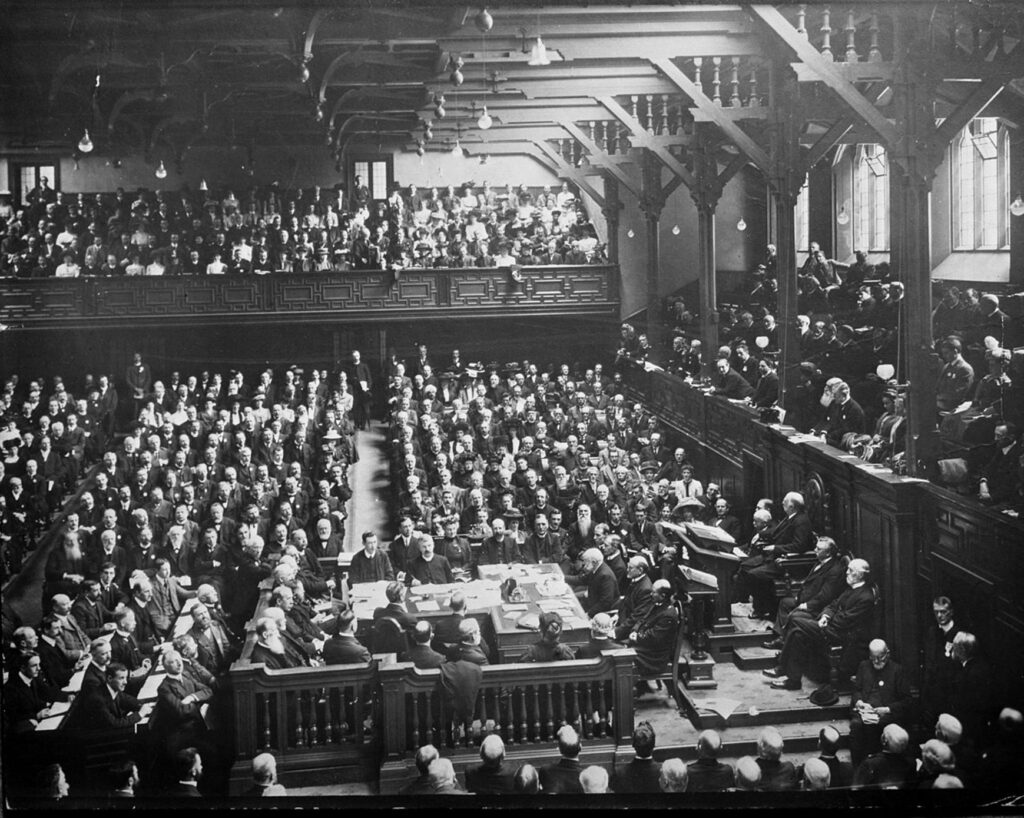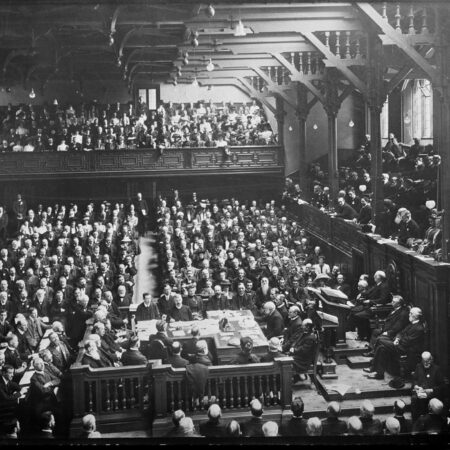Of his latest article about Scottish church history, Paul James-Griffiths of Christian Heritage Edinburgh writes, “This week’s article is all about the famous World Missionary Conference in Edinburgh in 1910. May Scotland regain its passionate desire to reach both our nation and the world again with the gospel.”

1910 World Missionary Conference, Public domain, via Wikimedia Commons
It is June 1910, and crowds of people pressed into the Assembly Hall of the United Presbyterian Church next to Edinburgh’s Royal Mile. There was a sense of excitement and confidence as the delegates patiently filed their way into the building and found their seats. A slogan was very much on the tongues of many present: “The Evangelization of the World in This Generation.” This was the third Protestant World Missionary Conference, the others being held in London (1888) and New York (1900), but Scotland had been chosen as the hosting nation this time because of its famed impact on world mission.
In 1824 the Church of Scotland experienced a watershed moment in its history, when the evangelicals dominated the General Assembly. The cry of Revd John Erskine in 1796 for world mission had finally fallen on fertile ground. By the 1840s Dr Chalmers could write, “There never was an age of the world in which a more effective machinery for conversion was, in the shape of schools and Bibles and missionaries, put into operation.” Scotland was dubbed “The Land of the Book”, and Edinburgh, in particular, became an evangelical hub and missionary training city. In every area of life in Scotland Christians were salt and light, leavening the whole culture, from education, law and business, to social reforms, science and medicine. Numerous mission societies were working together in unity alongside the church denominations.
By 1874 the Monthly Visitor committee could report that no other English language periodical of any sort had been so widely distributed in the whole of Scotland than their series of gospel tracts, and that all over the nation, “not fewer than from seven to eight thousand Christian men and women are employed from month to month in this labour of love.” The tracts were written in a range of styles to suit every type of person, from “the peer in the palace to the beggar in the street.” By 1899, the report tells us that 55,281 tracts were distributed in Edinburgh every month, and that every family was being reached, with a total number of 663,376 tracts being annually distributed nationwide by “an army of ten thousand workers”. Three great revivals (1839, 1859 and 1873) had erupted, transforming tens of thousands of people. There was a sense of triumph as the 20th century approached. In Edinburgh the Christians were exuberant: “The number of distributors engaged in the work exceeds 1000 [in Edinburgh],” the Monthly Visitor reported. “We are gradually overtaking the whole of the city, and hope that we may be able to state that this has been done before the new century begins [my emphasis].”
This, then, was why Edinburgh was chosen to host the World Missionary Conference of 1910, for it was a role model for both home and world mission. Among the delegates represented were the Archbishop of Canterbury, Archbishop of York, seven Anglican bishops, Scottish Episcopalian bishops, moderators of Presbyterian churches, and leaders across the Protestant denominations, as well as a host of missionaries. The event has been dubbed as the beginning of the first formal ecumenical movement in church history, although such an accolade would be an exaggeration; it was more of an official Protestant ecumenical gathering that had come into being through the accumulated efforts of many since the previous century. Back in 1806 William Carey of India had written to his friend Andrew Fuller about his vision for a coming together of churches for world mission:
“Would it not be possible to have a general association of all denominations of Christians, from the four quarters of the world? … I earnestly recommend this plan, let the first meeting be in the year 1810, or 1812 at furthest. I have no doubt it would be attended with very important effects; we could understand one another better, and more entirely enter into one another’s views…”
Of the 1,215 delegates representing the Protestant world in 1910, most were drawn from Britain, America and Europe. Of the groups and mission societies gathered under one roof, sixty were from America and Canada; forty-eight from Britain; forty-one from Europe; and twelve from South Africa and Australia. Awed at times by the massive task before them, they were at the same time deeply encouraged. When the Hon. T.H. Yun from Songdo in Korea stood up to speak they were on the edge of their chairs with expectancy. “Twenty-five years ago,” he said, “there was not a single missionary and not a single Christian; today there are nearly two hundred thousand Christians in Korea.”
The reports of gospel advances in many nations stirred up a sense of passion and urgency, felt by most of the delegates at this historical gathering. “The Church is confronted today, as in no preceding generation,” the first report stated, “with a literally world-wide opportunity to make Christ known… Never before has there been such a conjunction of crises and an opening of doors in all parts of the world as that which characterises the present decade… It is the day of God’s power. Shall His people be willing?”
As the crowds left the Assembly after the final meeting, challenged by the task, but buoyed up by many encouraging testimonies of church growth and break-throughs in the world, little would they have realised what was just around the corner. When the First World War hit Europe between 1914 and 1918, causing mayhem and the bloodshed of some 15 to 20 million people, world mission was shelved. Christian leaders had hardly regrouped for another mission push when the Second World War ignited, leaving a field of broken dreams and the carnage of another 70 to 85 million dead. The slogan of the 1910 conference, “The Evangelization of the World in this Generation”, now seemed to be hollow. Besides this, later generations of missiologists began to bring to the church a more sobering picture of the thousands of unreached tribes – far more than had been estimated in 1910. A huge work needed to be done. By 2025 however, the gap has been closing, as we inch our way to the finishing line. That day will certainly come, “For the earth will be filled with the knowledge of the glory of the Lord, as the waters cover the sea” (Habakkuk 2:14, NKJV).
